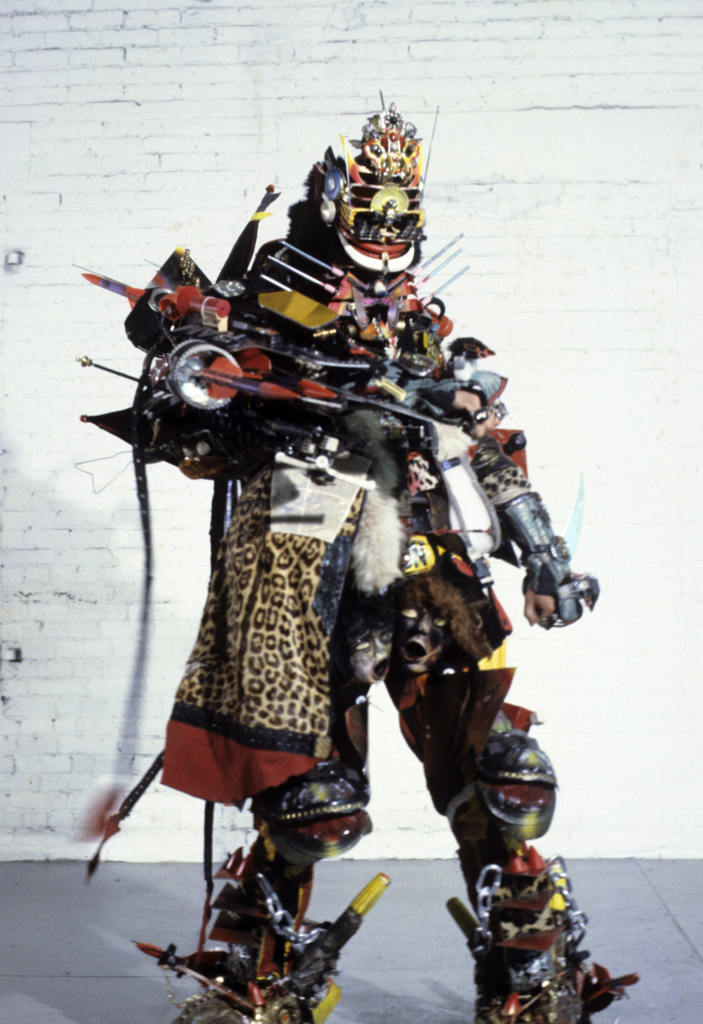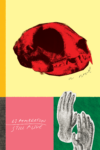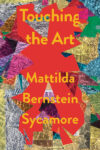
I first encountered Rammellzee as a photo in a chic artist’s loft — the new kind of artist’s loft, built right next to the old kind, a big silver ice cube rising up over aging industrial stock. The building gleamed in the sun and was covered in balconies and sweeping banks of windows with excellent views of the nearby park. Whenever I visited the loft I stood out on the balcony to watch the people below and enjoy the breeze. A few months earlier, I’d moved to New York from Minneapolis to become a writer and in the meantime had gotten a job cleaning upscale apartments. The work had some perks; the most immediate — besides balconies and artisanal snacks in the pantry — involved anthropological intrigue. I spent a lot of time wondering at my clients’ stuff.
In the photo, Rammellzee wears a big cloak trimmed in leopard print, a stack of ‘80s-future sunglasses, chunky necklaces, possibly African print fabric, a samurai-looking belt, a fuzzy animal tail, ear muffs, and a sword. He was hung on a stainless steel fridge in a granite-countered kitchen that opened out onto a living room filled with blown glass vases, state-of-the-art stereo equipment, modular suede furniture, limited edition prints, and intelligently lowbrow knick-knacks. The artist who lived here was famous for her colorful, collage-like paintings and kept her apartment like a catalog-ready version of that. Every week I came to fluff the pillows and add a layer of shine.
After a few weeks of cleaning the painter’s place, I got curious enough about Rammellzee to look him up. I found out that he was a New York graffiti writer-turned-performance artist who’d produced a sprawling body of work about a fictional war to wrest control of the alphabet from the generalized powers-that-be. In his invented universe, graffiti writers were the war’s vanguard and had inherited the mission from Gothic monks. Rammellzee spent his life producing bricolaged canvases, costumes, figurines, plays, raps, and manifestos to record the history of this writer’s war and the philosophies that animated it. He favored mathy science puns, had an MC’s rolling wit, and was fond of issuing pronouncements like the uni cannot verse itself and the nation is an integer.
By all accounts, Rammellzee was a disorienting presence to encounter. He wore costumes for most public appearances, slid in and out of personas from his writer’s war without warning, and introduced himself as an equation (stylized accordingly with sigmas: RAMM:ΣLL:ZΣΣ) to everyone he met. Officially, he was a function: a specialized equation you could feed inputs to receive clear, plottable outputs. Rammellzee encouraged people to treat his work as such, lacing it with elemental figures like NECESxSIT=IES and a mock-edifying professorial tone. His fans played along. Rammellzee is on purpose . . . [t]he Magic Scriptulator was Bootsy Collins’ appraisal. Jim Jarmusch swore you could talk to [him] for 20 minutes and your whole life could change.
People liked the idea that, from somewhere within the weirdness, Rammellzee was summing up something big and important. So if, in the midst of the scrubbing, I followed my curiosity about Rammellzee as though he knew the secrets of the city in which I’d just landed, I had a whole tradition that came before me. Who were we? We believed in the functionality of weirdness. We were in need of a bit of edification.
LOFxT~S
The painter’s wasn’t the only one; my job meant I spent a lot of time in the city’s chicest, airiest lofts. The buildings were sought-after and always proliferating. Inside, though, their built-in shelving units scratched easily and staticked back dust the instant my rag left them. And their geometric drain covers caught thick skeins of hair and clogged more often than not. And their hi-gloss cabinets stubbornly collected fingerprints, and their stone tiles sprouted mildew at spooky-prodigious rates.
There was one apartment I cleaned, in a shimmering glass egg of a building, that seemed to exemplify the problem. The apartment’s entire west-facing wall — and a good chunk of the south-facing one — was made of windows that gaped out at the street-scene below. They were cheap, though, or the loft poorly ventilated, or some other structural thing had gone awry, because every morning without fail they produced buckets of condensation. It gathered in fat beads across the glass like feverish sweat. When the beads broke they ran down the windows, leaving pools of water on the metal sills and floor. I’d wipe them up only to have them reappear half an hour later, at which point I’d do it again, and then again, triaging with soggy rags ad nauseam until it was time to go home.
Rammellzee had different names for the enemy he was fighting, but the lightdwellers was a favorite. In the world of the writer’s war, the term referenced a generic societal elite that ran things aboveground while graffiti writers spray-painted subway tunnels in protest below. Lightdwellers could also be deployed in a targeted way to evoke government people or white people or religious people or art people handing down judgment from within white-walled galleries. Depending on the moment, Rammellzee might say lightdwellers and mean one or two and a half of them, or some other enemy that had temporarily drifted into his crosshairs. It was a handily elastic piece of language.
The lofts can do a similar job for a certain kind of New Yorker; ditto for condos. When deployed correctly and in the right company, they neatly abbreviate the consequences of decades of urban revitalization initiatives — from corporate tax breaks to rising rents to broken-windows policing — with a distinct note of disapproval. When deployed correctly and in the right company, you don’t need much more to get your point across. I went to protest a plan to convert a Brooklyn hospital to luxury condos and saw a woman carrying a grey sign shaped like a tombstone, painted with dripping red letters that read, with perfect concision, Condos rise, Brooklyn dies.
I soon realized I’d missed the city I’d tried to move to — the pulsing cultural vanguard — by at least twenty years. I saw it eulogized neatly in a headline occasioned by the release of a new book of photography: A Place That Can’t Exist Again. The book chronicles a famous pop star’s early punk years, which were also Rammellzee’s early hip-hop years, the two of which overlapped with other activist and intellectual circles in the alchemy of the ‘80s downtown art scene. The book is filled with images of cheap rents and ferocious young people and the general air of creative promise. It’s an easy era to romanticize, and the artifact costs $55.
I am suspicious of cheap nostalgia, of what it warps and omits. I’m even more suspicious of the people who never entertain it, and I met them every day. One night, on a blind date with an architect, I launched into a tumbling complaint about the lofts and the things they were killing and he cut it off quick, like he’d heard it all too many times before. History was filled with the stories of neighborhoods turning, he lectured indulgently, and the nature of cities was to change. This was inevitable stuff. I was a sweet naïf.
T+R=ASH
Rammellzee also called himself the Garbage God, an obvious enough nickname since all his art was made of it. For decades, he lived in a cavernous former warehouse dubbed the Battle Station and filled it with appliance knobs, plastic darts, toy vampire teeth, and assorted other junk that sooner or later found its way into his work. He scavenged eccentrics, like Gary Johnson, a toymaker and eventual collaborator, whom he discovered one day ripping up flowers in a landscaped bed near the Battle Station. He collected stray ideas from physics texts, samurai imagery, hip-hop cadences, and Five Percenter teachings. And he claimed Gothic monks as forebears because the brambling letters in their illuminated manuscripts reminded him of wildstyle.
He stitched everything together with obsessive, impressive coherence. Carlo McCormick remarked on the seamlessness of [the] conceptual invention beneath the patchworked veneer; Henry Chalfant judged Rammellzee’s work, while otherworldly, as nonetheless rigorously elaborated. According to Rammellzee’s wife Carmela, the garbage caches were always carefully organized and indexed for future use. He had a place for everything and nothing slipped through the cracks.
This strikes me as the garbage picker’s first and toughest battle: maintaining a sense of logic in the face of dirt and chaos. At my workplace, though, the trash was uncannily neat and consistent. There was a lot of it but it all shared a lightly-used sameness: the unworn dove grey tights matched the almost-full bottle of salon shampoo matched the extra wireless keyboard. It was as though I’d been tasked with excavating the artifacts of some clan of post-garbage citizens who had consumed themselves past the point of ugliness and entropy. Even their waste was pretty and orderly. And still it was camouflaged meticulously in garbage drawers, perfumed bags, sleek silver cans, and hidden trash chutes. And still it was my hands that were responsible for making it disappear.
L+OVE
I spent a lot of time thinking about what made the lofts desirable. Most of the time I imagined it as a sort of turbo-newness that promised a world without a hint of what came before, but I met a guy on the train who made me rethink that formulation. The guy worked construction and often found himself on jobs putting up luxury loft buildings, which, he confirmed, were often rushed to shoddy completion. I told him I cleaned those spaces and we quickly fell into winking loft shorthand: steel granite glass bamboo brushed metal exposed brick, the final one an especially ubiquitous feature of our workplace. He shook his head. Why did people love raggedy old brick? Especially white girls, he laughed hammily, they see a brick and it’s over! And then, after a beat: No offense. He told me he was married but guessed some guy with a predilection for white girls could make that work for himself. I imagined that guy on the corner, waving a brick in the air, white girls pulling each other down by the ponytail to get at him, and giggled. The train screeched to his stop. You take care, he said.
A few months after I arrived, a new friend invited me to eat dinner at Meredith Monk’s loft. I looked up Meredith Monk and was pleased to see I’d been invited to the old artist loft of a composer known for her textured acapella layered over odd lyric films. My friend had a friend who worked as Monk’s assistant and was taking advantage of a night with the boss out of town. I couldn’t be more enthusiastic about this, she gushed by email. It’s like a tidal wave of desire when I think of that big dirty loft in Tribeca. We showed up to a giant space with peeling paint and raw brick and rickety stuffed bookshelves and small clutters of flags and gifts and plants and a dusty grand piano and note cards tacked around in various stages of thought. Things were shimmed and patched and the rescued wood chairs were decidedly uncomfortable. Still we raided bottles of herbs sticky with last decade’s oil to make lumpy pizzas and dreamed of lives lived inside a space like hers. What was so desirable about it? Something to do with making one’s home honestly inside time and history. Something about being familiar with the concrete character of decay.
The Battle Station used to be just down the street from Monk’s place. Rammellzee was evicted shortly before he died in 2010 after squatting for most of the twenty-some years he lived there. Presumably, the landlord got sick of not profiting from Tribeca’s skyrocketing rents. So Rammellzee pulled the canvasses off his own peeling paint and brick, packed kimonos and trinkets and toys into boxes — coffins, he told the writer Dave Tompkins — and took up residence at a brand new building in Battery City, his consolation prize the big private garbage room filled with his wealthy new neighbors’ trash. And Tribeca filled up with the new lofts that quoted the old in small, riskless bits.
T~HEFT
When Rammellzee died, two years before I arrived, galleries and museums lined up for the right to show pieces from his estate. The resulting exhibits claimed him as the kind of lovable weirdo only New York could produce, conveniently neglecting the fact that at heart his body of work was one long declaration of war on the city and its elite. When he was alive, Rammellzee experienced the art world’s attention ambivalently. He sold work to big name museums and had gallery representation. He traveled to Japan, Italy, and Holland for performances. In a certain mood, he relished ticking off his prestigious shows and name-dropping the famous people he’d met.
In another sort of mood, he observed it all darkly. Graffiti is a word, he told a 149th Street blogger, that society placed on people it did not possibly understand. Before we could grow up and make our own determination of what technique or iconic statement we were doing, they decided . . . to call us scribble, scrabble artists. He mourned what his budding culture might have become besides an entré into some downtown gallery.
One day at work in Chelsea — at a giant boutique loft on a block full of warehouses-turned-galleries — the stylish lady of the house pointed out a room-spanning window to a building going up a few blocks away. When completed it was going to obstruct the views of the multi-million dollar condos next door. Her eyes tracked a crane hoisting metal beams to a floor several hundred feet above us. She grinned conspiratorially. She and her husband — successful illustrator and fashion photographer, respectively — had gotten into the neighborhood early, before it had gotten so expensive. I watched the crane for a while, too, and the beams wobbling ever so slightly, then grunted and took a vacuum to their white cowhide rugs.
This was absurd, of course. The woman whose toilet I had just cleaned was asking me to help her lampoon rich people. I was briefly pissed. The anger passed quickly enough, though, because in the end I liked the illustrator. She’d discovered I was a writer soon after I started working at her apartment, and we’d clocked good hours talking about all things creative: books of short stories, music documentaries, ideas for drawings, shows being mounted at the gallery around the corner. We weren’t friends, but we were friendly, which made me think her bit of commentary had been more than a misrecognition of class difference. It was also a hypothesis about one of our favorite topics of conversation. As though aesthetic sophistication equaled an oppositional ethics. As though liking art was the same as fighting the good fight. She’d looked to me to confirm it.
Of course, in the most basic sense, the conversation was about guilt. She was asking me if she was implicated in the changes happening around us. She saw the lofts going up and could imagine plainly enough what came next — the displacement of whole swaths of poorer (probably black or brown) New Yorkers, the streets remade for bland luxury lifestyles — and wasn’t sure she wanted it done in her name. But on some level it was, and she was casting around for something that could make her feel innocent.
These conversations — or non-conversations — happen all the time in gentrifying New York. People claim all sorts of affinities to deflect guilty feelings: a special love for the local, a theoretical commitment to equality, a cold intellectual objectivity, and on and on. There are special ironies to choosing art, though, at a moment in which arts corridor designations are a favorite revitalization trick, public art projects constitute a commonsense clean-up strategy, art consumption has become a popular edifying pastime, and the presence of artists in a neighborhood is treated as first-step gentrification fodder. There are special ironies to choosing art as the late-capital art machine does a better and better job of claiming oppositional voices as its own, more and more efficiently absorbing the style of the Rammellzees with none of the fight.
This is one way to talk about the function of Rammellzee’s weirdness. In a city that prides itself on the cultural output of its misfits while cannibalizing their lives for profit, weirdness is a way of simultaneously critiquing it and protecting oneself. Rammellzee punned, obstructed, misdirected, and maintained outright silences and did so, like Bootsy Collins said, on purpose. He called the label graffiti a curse and advanced veiled arguments about both cultural appropriation and the potentially more expansive purpose of art in the lives of its practitioners. He insisted he was a Gothic Futurist not, as many critics called him, an Afrofuturist, and gave himself a space ambiguous enough to express a racial politics that didn’t brand and own him. He practiced careful personal discretion, saving facts as basic as his birth name for himself and those who knew him well. He lived the hypothesis that, as he once lectured Dave Tompkins, [t]oo much information in the room is bad policy.
FAMILY=
As he got older, Rammellzee became a recluse, squirreling himself away at the Battle Station and then in Battery City to work on his art and wage his war. Occasionally he left home to do a show or an interview. I watched a video of one such excursion, a webcast interview with Rokafella, the noted breakdancer. The talk began innocuously enough but soon, in response to a question about his latest work, Rammellzee was talking about the letter alpha and Egyptologies and the Indo-Germanic language tree and Rokafella lost the thread. Are we gonna be able to understand this, she asked, or are we gonna be like AHHH?!
A sharp look — at once irritated, tired, and lonely — flashed across Rammellzee’s face. Well, look at the front of the dictionary, he admonished her, you will see there’s an Indo-Germanic language tree — adding, in an explanation of stakes, it all came from wars.. They kept not connecting for a few minutes before Rammellzee excused himself with a clipped I am out. He made for the door and was gone. For all that weirdness and euphemism could provide, it wrought this alienation, too.
Rachel Khaadzi Ghansah writes about Rammellzee just briefly in an essay that is first and foremost about Trayvon Martin’s friend Rachel Jeantel. The essay tracks the contempt shown Jeantel during George Zimmerman’s trial and an expressive tradition Ghansah calls the art of being young, black, and incomprehensible. In her mind Rammellzee’s weirdness is not only obviously on purpose, it’s meant to be in conversation with the real world. It’s meant to matter. This is, incidentally, one way to talk about Rammellzee’s reliance on the equation metaphors: it was a way to claim legitimacy, relevance, and real-world import.
Before settling into life as an artist and an equation, Rammellzee tested a handful of other career paths: boat repair, dentistry, and fashion design. He told writers at the magazine ego trip that he would have been happy to keep repairing boats. You work with good people, you’re swimming, and you’re getting exercise and you’re fucking with sharks, he said — by which I think he meant it might have been nice to lead a simple, scrutable life. But you come into the city, he shrugged, because they need you.
On the first anniversary of my arrival, I paid a visit to the site of the Battle Station, expecting to see it torn down in favor of a big new building. But it was still three stories of older-looking brick, albeit now fitted with ornamental balconies and painted a fresh jazzy red. I approached the door and rang the bell to his old apartment. After a moment a woman answered and I pled my case. She listened and responded politely that I couldn’t come upstairs. The building’s been gutted since then, she said.
I boarded the train thinking about dripping grey tombstones and then, calming, what sort of action might lie beyond. I was glad to have visited to the Battle Station and glad enough to have been rebuffed. I watched my fellow passengers, vulnerable at the end of their days, rubbing eyes and temples and rustling grocery bags for a meal long past due. The train hurtled through the dark tunnel towards home.
This post may contain affiliate links.







